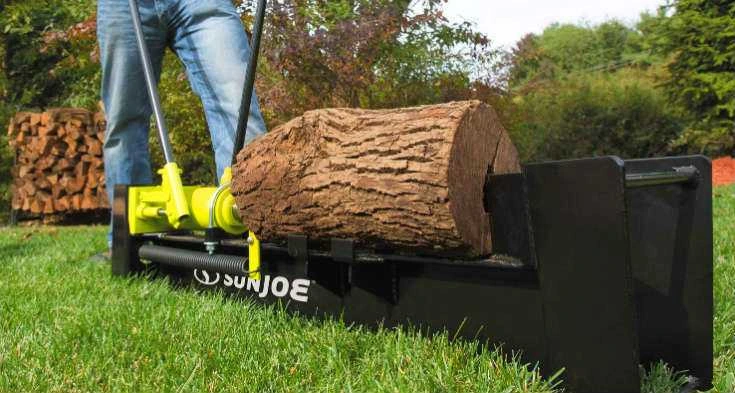Wood splitting might be a right of passage or a call back to yesterday for some. We would describe it as a hassle. Spending hours using an ax to split logs into smaller pieces can wreak havoc on a person’s back. If those rounds get large enough to require a sledgehammer and a wedge, it’s time to contact Paul Bunyan. There is a more reasonable solution. Log splitters are fast and efficient. What is a log splitter? Let’s take a closer look at these tools and discuss what we feel is the best log splitter in three distinct categories.
Why Would You Need a Log Splitter?
There are a few reasons that someone would need a log splitter including chopping large quantities of logs into usable firewood. Often, these logs (also called “rounds”) are too big to fit into a fireplace or wood burning stove. Using a felling axe will work on smaller logs, but it will require a lot of hard work to chop through a pile of rounds. It will also take a lot of time.
If the logs are too big for an axe, they will require a hammer and a wedge to split them. Alternatively, you could use a chainsaw. No matter how you look at it, a good log splitter will save you time for a considerable amount of timber, even compared to powerful gas chainsaws. They can also save you from the back-breaking work that will be required. Even if you do not wish to chop your own firewood, you may still need to remove fallen or fresh trees from your property.
There is a commercial aspect to owning the best log splitter. You may be interested in going into the firewood business. Or, you could be considering starting up a property clearing service. Even when you are not using the log splitter yourself, it could be rented out for others to use, securing another source of income.
Here is a short video from Crazy Russian Hacker demonstrating the difference between splitting wood with a log splitter vs axe. The ultimate question is, what is the best log splitter?
Best Electric Log Splitter Reviews
WEN 56207 6.5-Ton Electric Log Splitter with Stand
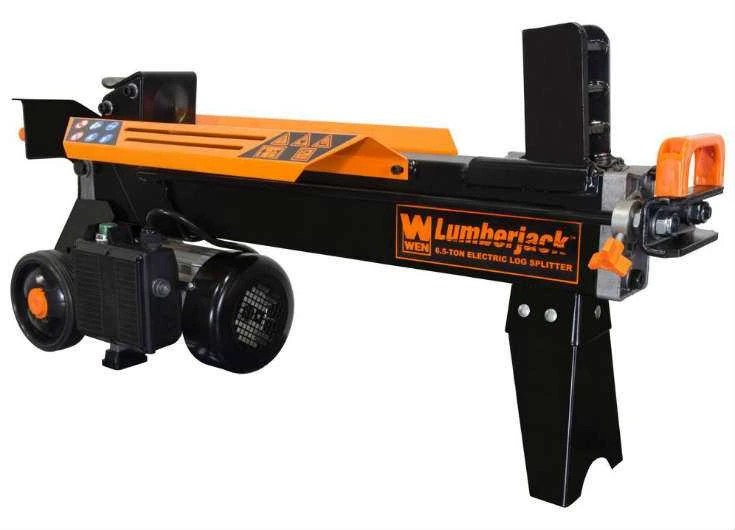
6.5
Tonnage (Ton)
15
Motor (Amp)
The first thing that we noticed about the WEN 56027 was how compact it is. Measuring less than 39-inches and weighing only 98 pounds makes this a good choice for someone looking for a motorized splitter that can be moved around by one person.
The stand that is included allows this splitter to stand a comfortable 34-inches off of the ground. The versatility of detaching the stand and wheels to create a tool that sits on the ground is a nice touch.
The five-inch wedge is sizable at this tonnage and allows the manufacturer to claim splitting power on 10-inch diameter logs. We would recommend thinner diameters with fresh cut rounds. A 6.5-ton rating is a good choice for those who will be chopping home firewood from smaller logs. This small hydraulic would work well in a workshop.
Best Gas Log Splitter Reviews
YARDMAX 28 Ton Full Beam Gas Log Splitter
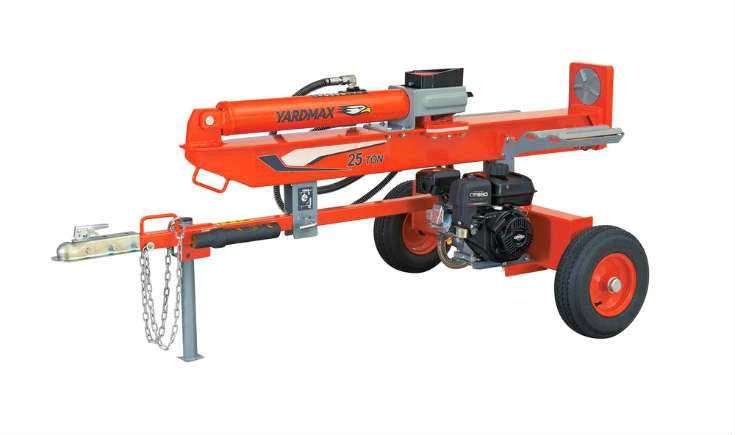
28
Tonnage (Ton)
208
Motor (Amp)
For those who admire versatility, the YU2566 25-ton is something to behold. There is plenty of power supplied by the Briggs & Stratton engine behind the tonnage rating.
Full advantage can be taken on larger logs thanks to the horizontal and vertical capabilities. The log spinner on the footplate is a nice feature for those splitting logs in vertical mode.
When this YardMax gas splitter is operated in a horizontal mode, the dual log cradles located on either side of the wedge will help to prevent the wood from falling.
We were appreciative of the durable U-Beam design and the additional log stripper plates that were included. The 9.7 cycle time is even more impressive when using the four-way split technology on smaller rounds. Splitting rounds into four pieces in that time is incredible for a hydraulic.
Yardmax has half beam log splitter too that is worth checking out as well.
Best Manual Log Splitter Reviews
Sun Joe LJ10M Logger Joe 10 Ton Hydraulic Log Splitter
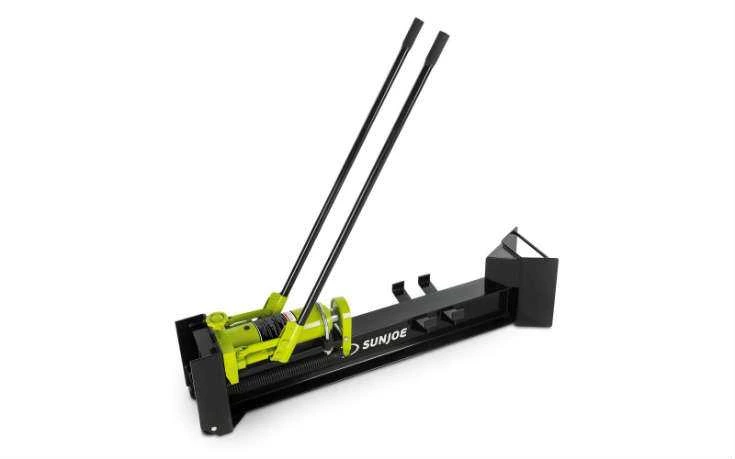
10
Tonnage (Ton)
208
Motor (Amp)
Sun Joe has offered a log splitter that pushes the tonnage rating on manual hydraulic units. A rating of 10-tons would be ideal for almost any type of tree cleanup in the yard.
The 18-inch maximum log size should provide firewood that will fill almost any fireplace or woodstove out there. It should be noted that the durable steel does bring the weight of this unit up to 87-pounds, but that steel also means this log splitter is designed to last.
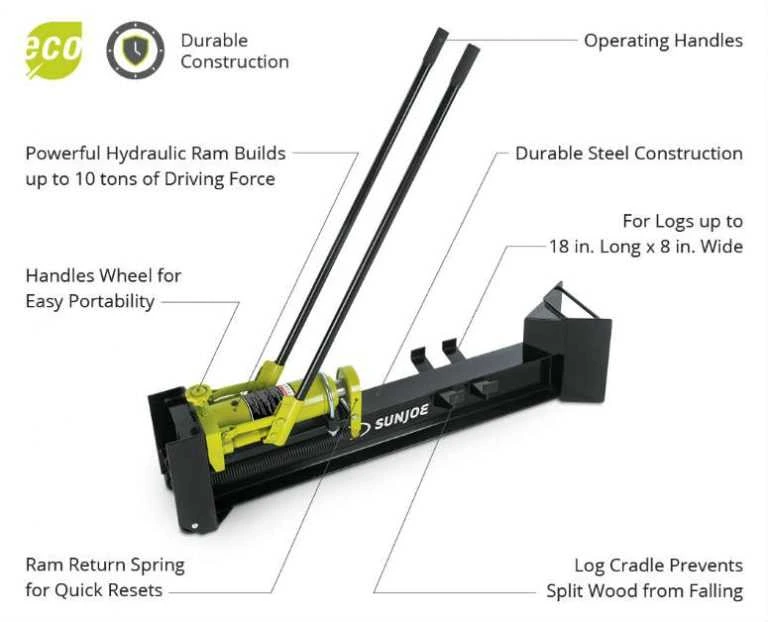
The longer handles will make operation while this hydraulic sits on the ground easier. They also provide maximum leverage for building up the force needed to split logs up to eight inches in diameter. The knob on the piston allows for a quick reset. Everyone should feel confident with the two-year warranty added on.
Types of Best Log Splitters
Manual
When it comes to splitting firewood, many people will instantly think of a hand ax. If the rounds are too large, one would think of using a large sledgehammer and a wedge. While these traditional methods do work, there are more effective manual tools available. A slide-hammer manual log splitter uses kinetic energy to do the splitting.
A pole is attached to the top of a wedge. A weight is attached to the pole and is used like a sledgehammer. When the weight slides down the pole, the energy generated will drive the wedge into the wood. The only real advantage to this system is that it eliminates the possibility of a missed hammer strike.
The best manual log splitter is a hydraulic unit. This tool requires the use of hand levers that are pulled back and forth to force a wedge into the wood. These log splitters are cheaper and more mobile than motorized units. It takes a long time to split wood and is very limited in the size of logs it can handle. If you need a cheap log splitter, we recommend going for a manual one for sure.
Electric
This type of log splitter will employ an electric motor to operate the machine. The benefit of using a motorized log splitter is that it saves you from the labor-intensive work. It will split logs faster than by hand, saving time. Electric splitters can split logs that a manual tool cannot.
An electric wood splitter model has a few advantages over a gas-powered system. Electric log splitters are more lightweight than most gas splitters. The best electric log splitter advantage over gas models is that they can be used indoors. They do not require gas or oil to operate either.
Gas
A gas splitter uses a more powerful motor than electric models have. This extra power allows a gas splitter to cycle faster and also allows it to handle wood that an electric one cannot. It is capable of splitting freshly cut wood that an electrician will struggle with. A gas model has the power to split hardwoods that an electric engine is unable to split.
One of the best gas log splitter features is its portability. An electric model’s range is limited by the length of an electrical cord or the use of a generator. A gas splitter does not have these limits. It does have some limitations when compared to an electric log splitter, however.
Gas log splitters cannot be used indoors due to their exhaust fumes. Their engines are much louder than an electric motor. They require gas and oil to operate. They are dirtier and have more moving parts that could potentially break down. This means they require more maintenance.
Vertical vs. Horizontal Log Splitter
Many log splitters are horizontal in design. The tool offers a place for the log to sit while it is split. It must be loaded by hand, which will require an operator to lift the log onto the machine. This can be difficult work with larger rounds and may require extra hands to avoid a back injury.
This is where a vertical splitter will outshine a horizontal splitter. An operator does not have to lift large logs off of the ground to load them in position with a vertical model. The large rounds can simply be rolled and turned onto the platform. This allows a single person to load logs that they could not safely handle by themselves.
Hydraulic vs. Kinetic Log Splitter
A kinetic splitter combines the use of flywheels and pinion gears to produce a quick release of energy that drives the wedge. The quick release of energy is activated by a lever. This style of the mechanism is fast acting and produces a quick cycling rate. A faster cycling time is an advantage when a lot of smaller cuts are required.
A hydraulic unit applies sustained pressure on the wedge to produce a split in the wood. While the best hydraulic log splitter may have cycle times close to a kinetic model, it will never be as fast. Hydraulic splitters produce more power and are capable of working on fresh, hard, and wet woods that kinetics struggle with. Besides speed, their only other disadvantages are more moving parts and the need for hydraulic fluid.
Key Considerations when Choosing the Right Log Splitter
Tonnage Rating
Tonnage rating is an important guide when determining the size of logs that can be cut by a log splitter. When splitting wood, the diameter of the log is used as a base point in determining the tonnage rating. The other consideration when calculating the tonnage required is if the wood is seasoned or green. Greenwoods are freshly cut and contain moisture that makes it more difficult to split, while seasoned wood is dry and brittle in comparison.
A six-inch diameter log can be split with a minimum of four tons of force. With a 12-inch seasoned log the minimum tonnage increases to seven tons. The same 12-inch log that is green will require 16-tons minimum. A 24-inch seasoned log requires at least 20 tons, or rather a 22-ton log splitter, while a green log of that diameter will need at minimum a rating of 30 tons.
Other wood factors play a role in tonnage requirements. Hardwoods like Oak and Walnut will require more tonnage to split than softer Pinewoods will require. If the wood contains a lot of knots it will require a higher tonnage rating as well. All of these wood characteristics must be combined to determine the minimum rating required from the log splitter.
Log Length
The length of the logs being split is limited by the length that the splitter can handle. If the wood diameter is approaching the limits of the tonnage rating (or exceeding it) the length of logs should be shortened. Vertical log splitters are capable of splitting longer logs than horizontal models can in many cases. The maximum length of the final firewood produced after splitting will be determined by the size a fireplace or wood-burning stove can hold.
Cycle Times
Cycle times may not matter for most homeowners chopping wood, but they are an important consideration for commercial applications.
Hydraulic splitters can take up to 30-seconds for a cycle, with the shorter times ranging from 10 to 15-seconds.
A kinetic splitter is can be up to six times faster, with speeds dropping down as low as 2.5 seconds per cycle. The only way to properly take advantage of such short cycle times is to have multiple people working together.
Keep in mind, that the best log splitter is effective, efficient, and has the right cost-to-performance ratio.
Portability
Manual log splitters are easily the most portable splitters and can be manhandled to and from. Electric splitters are heavier than manuals but lighter than gas-powered units. Their range is limited by their need for electricity, and a generator will be needed to allow them the ability to roam. Gas powered splitters are usually the heaviest but can go wherever they can be delivered.
Single vs. Two-handed Operation
A single-handed log splitter requires only one hand to operate the functions during the splitting process. This allows the operator to have one hand free. A log splitter is a dangerous tool, and manufacturers design many of their products in a way that requires both hands to operate. This safety feature helps to keep hands out of harm’s way.
Cost
Log splitters are not cheap but very effective. As an average homeowner with some woods, it makes sense to find the best log splitter under $1000, as it will have decent performance but would not cost the Earth.
If you are lucky, you can find a good quality 22 ton log splitter for just under 1000 dollars or around that mark.
The best advice is to avoid suspiciously cheap log splitters, tools like this are long term investments and you don’t want to end up with a pretty overpriced paperweight, do you?
Conclusion – The best log splitter
Once you have finished filling or got to your timber through other means (like killing a tree in your backyard) it is now time to get those logs split.
Wood splitting for clean up or firewood can be done more quickly and easily with the proper tools. Log splitters provide these benefits at various levels of equipment design. Large rounds can be worked in a similar fashion as smaller logs with proper planning and understanding of a tool’s features. We hope that the information that was provided helped improve the understanding of the different log splitter designs.
There are many factors that will determine what the best log splitter is for a particular individual. The major consideration is the wood being split. Wood type, density, diameter, freshness, and length all play a role in determining what tool is needed. Once these parameters are understood, a customer can determine the tonnage rating and power source required for the log splitter.
Make sure to take a further look at the products mentioned above and get to splitting!
